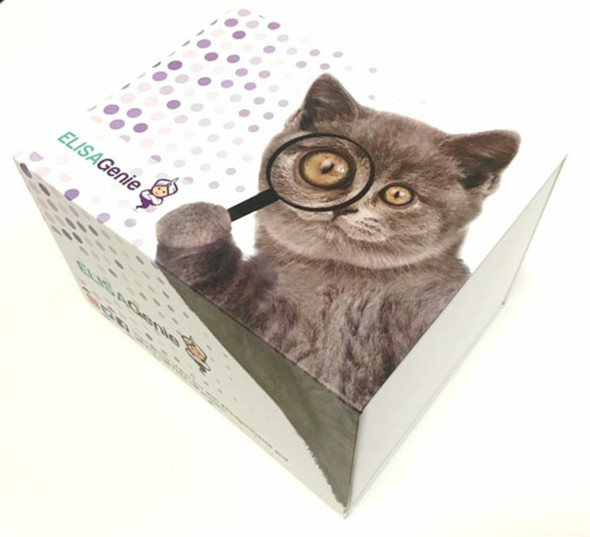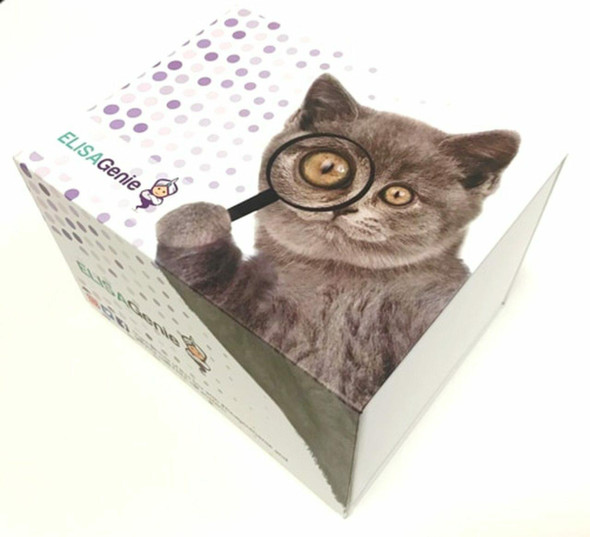Human GRIN2B (Glutamate Receptor, Ionotropic, N-Methyl-D-Aspartate 2B) ELISA Kit (HUES02633)
- SKU:
- HUES02633
- Product Type:
- ELISA Kit
- Size:
- 96 Assays
- Uniprot:
- Q13224
- Sensitivity:
- 0.19ng/mL
- Range:
- 0.31-20ng/mL
- ELISA Type:
- Sandwich
- Synonyms:
- GRIN2B, GluN2B, MRD6, NMDAR2B, NR2B, hNR3,Glutamate [NMDA] receptor subunit epsilon-2,N-methyl D-aspartate receptor subtype 2B
- Reactivity:
- Human
- Sample Type:
- Serum, plasma and other biological fluids
- Research Area:
- Signal Transduction
Description
Human GRIN2B (Glutamate Receptor, Ionotropic, N-Methyl-D-Aspartate 2B) ELISA Kit
The Human GRIN2B (Glutamate Receptor Ionotropic N-methyl-D-aspartate 2B) ELISA Kit is a highly reliable tool for the quantitative detection of GRIN2B levels in human serum, plasma, and cell culture supernatants. This kit offers exceptional sensitivity and specificity, ensuring accurate and reproducible results for a wide range of research applications.GRIN2B is a key subunit of the NMDA receptor, a crucial player in synaptic plasticity and memory formation.
Dysregulation of GRIN2B has been implicated in various neurological disorders, including epilepsy, schizophrenia, and Alzheimer's disease. Therefore, this ELISA kit serves as an invaluable tool for studying the role of GRIN2B in these conditions and exploring potential therapeutic interventions.Get your hands on the Human GRIN2B ELISA Kit today and unlock new insights into the complex mechanisms underlying neurological disorders.
| Assay type: | Sandwich |
| Format: | 96T |
| Assay time: | 4.5h |
| Reactivity: | Human |
| Detection Method: | Colormetric |
| Detection Range: | 0.31-20 ng/mL |
| Sensitivity: | 0.19 ng/mL |
| Sample Volume Required Per Well: | 100µL |
| Sample Type: | Serum, plasma and other biological fluids |
| Specificity: | This kit recognizes Human GRIN2B in samples. No significant cross-reactivity or interference between Human GRIN2B and analogues was observed. |
This ELISA kit uses Sandwich-ELISA as the method. The micro ELISA plate provided in this kit has been pre-coated with an antibody specific to Human GRIN2B. Standards or samples are added to the appropriate micro ELISA plate wells and combined with the specific antibody. Then a biotinylated detection antibody specific for Human GRIN2B and Avidin-Horseradish Peroxidase (HRP) conjugate are added to each micro plate well successively and incubated. Free components are washed away. The substrate solution is added to each well. Only those wells that contain Human GRIN2B, biotinylated detection antibody and Avidin-HRP conjugate will appear blue in color. The enzyme-substrate reaction is terminated by adding Stop Solution and the color turns yellow. The optical density (OD) is measured spectrophotometrically at a wavelength of 450 nm ± 2 nm. The OD value is proportional to the concentration of Human GRIN2B. The concentration of Human GRIN2B in samples can be calculated by comparing the OD of the samples to the standard curve.
| UniProt Protein Function: | NMDAR2B: an NMDA receptor subtype of glutamate-gated ion channels with high calcium permeability and voltage-dependent sensitivity to magnesium. Mediated by glycine. Plays a key role in synaptic plasticity, synaptogenesis, excitotoxicity, memory acquisition and learning. Mediates neuronal functions in glutamate neurotransmission. In concert with DAPK1 at extrasynaptic sites, acts as a central mediator for stroke damage. Its phosphorylation at Ser-1303 by DAPK1 enhances synaptic NMDA receptor channel activity inducing injurious Ca2+ influx through them, resulting in an irreversible neuronal death. |
| UniProt Protein Details: | Protein type:Channel, ligand-gated; Channel, calcium; Membrane protein, multi-pass; Membrane protein, integral Chromosomal Location of Human Ortholog: 12p12 Cellular Component: postsynaptic membrane; synaptic vesicle; neuron projection; cell surface; integral to plasma membrane; dendrite; plasma membrane; cell junction; N-methyl-D-aspartate selective glutamate receptor complex Molecular Function:protein binding; extracellular-glutamate-gated ion channel activity; zinc ion binding; glycine binding; N-methyl-D-aspartate selective glutamate receptor activity; calcium channel activity Biological Process: synaptic transmission, glutamatergic; axon guidance; startle response; behavioral fear response; in utero embryonic development; glutamate signaling pathway; regulation of synaptic plasticity; learning; memory; synaptic transmission; detection of mechanical stimulus involved in sensory perception of pain; behavioral response to pain; sensory organ development; learning and/or memory; response to ethanol; suckling behavior; transport; ionotropic glutamate receptor signaling pathway; ephrin receptor signaling pathway; regulation of excitatory postsynaptic membrane potential Disease: Mental Retardation, Autosomal Dominant 6; Epileptic Encephalopathy, Early Infantile, 27 |
| NCBI Summary: | N-methyl-D-aspartate (NMDA) receptors are a class of ionotropic glutamate receptors. NMDA receptor channel has been shown to be involved in long-term potentiation, an activity-dependent increase in the efficiency of synaptic transmission thought to underlie certain kinds of memory and learning. NMDA receptor channels are heteromers composed of three different subunits: NR1 (GRIN1), NR2 (GRIN2A, GRIN2B, GRIN2C, or GRIN2D) and NR3 (GRIN3A or GRIN3B). The NR2 subunit acts as the agonist binding site for glutamate. This receptor is the predominant excitatory neurotransmitter receptor in the mammalian brain. [provided by RefSeq, Jul 2008] |
| UniProt Code: | Q13224 |
| NCBI GenInfo Identifier: | 14548162 |
| NCBI Gene ID: | 2904 |
| NCBI Accession: | Q13224. 3 |
| UniProt Secondary Accession: | Q13224,Q12919, Q13220, Q13225, Q14CU4, Q9UM56, |
| UniProt Related Accession: | Q13224 |
| Molecular Weight: | 1484 |
| NCBI Full Name: | Glutamate receptor ionotropic, NMDA 2B |
| NCBI Synonym Full Names: | glutamate receptor, ionotropic, N-methyl D-aspartate 2B |
| NCBI Official Symbol: | GRIN2B |
| NCBI Official Synonym Symbols: | MRD6; NR2B; hNR3; EIEE27; GluN2B; NMDAR2B |
| NCBI Protein Information: | glutamate receptor ionotropic, NMDA 2B; NR3; glutamate receptor subunit epsilon-2; N-methyl-D-aspartate receptor subunit 3; N-methyl D-aspartate receptor subtype 2B; glutamate [NMDA] receptor subunit epsilon-2 |
| UniProt Protein Name: | Glutamate receptor ionotropic, NMDA 2B |
| UniProt Synonym Protein Names: | Glutamate [NMDA] receptor subunit epsilon-2; N-methyl D-aspartate receptor subtype 2B; NMDAR2B; NR2B; N-methyl-D-aspartate receptor subunit 3; NR3; hNR3 |
| Protein Family: | Glutamate receptor ionotropic |
| UniProt Gene Name: | GRIN2B |
| UniProt Entry Name: | NMDE2_HUMAN |
As the OD values of the standard curve may vary according to the conditions of the actual assay performance (e. g. operator, pipetting technique, washing technique or temperature effects), the operator should establish a standard curve for each test. Typical standard curve and data is provided below for reference only.
| Concentration (ng/mL) | O.D | Average | Corrected |
| 20 | 2.363 2.367 | 2.365 | 2.277 |
| 10 | 1.462 1.5 | 1.481 | 1.393 |
| 5 | 0.946 0.906 | 0.926 | 0.838 |
| 2.5 | 0.451 0.475 | 0.463 | 0.375 |
| 1.25 | 0.262 0.244 | 0.253 | 0.165 |
| 0.63 | 0.185 0.177 | 0.181 | 0.093 |
| 0.31 | 0.132 0.14 | 0.136 | 0.048 |
| 0 | 0.079 0.097 | 0.088 | -- |
Precision
Intra-assay Precision (Precision within an assay): 3 samples with low, mid range and high level Human GRIN2B were tested 20 times on one plate, respectively.
Inter-assay Precision (Precision between assays): 3 samples with low, mid range and high level Human GRIN2B were tested on 3 different plates, 20 replicates in each plate.
| Intra-assay Precision | Inter-assay Precision | |||||
| Sample | 1 | 2 | 3 | 1 | 2 | 3 |
| n | 20 | 20 | 20 | 20 | 20 | 20 |
| Mean (ng/mL) | 0.93 | 2.89 | 6.78 | 1.01 | 2.82 | 6.78 |
| Standard deviation | 0.05 | 0.14 | 0.27 | 0.06 | 0.15 | 0.32 |
| C V (%) | 5.38 | 4.84 | 3.98 | 5.94 | 5.32 | 4.72 |
Recovery
The recovery of Human GRIN2B spiked at three different levels in samples throughout the range of the assay was evaluated in various matrices.
| Sample Type | Range (%) | Average Recovery (%) |
| Serum (n=5) | 90-101 | 96 |
| EDTA plasma (n=5) | 87-102 | 93 |
| Cell culture media (n=5) | 91-102 | 96 |
Linearity
Samples were spiked with high concentrations of Human GRIN2B and diluted with Reference Standard & Sample Diluent to produce samples with values within the range of the assay.
| Serum (n=5) | EDTA plasma (n=5) | Cell culture media (n=5) | ||
| 1:2 | Range (%) | 91-102 | 86-101 | 85-96 |
| Average (%) | 97 | 92 | 90 | |
| 1:4 | Range (%) | 89-102 | 86-98 | 89-102 |
| Average (%) | 94 | 92 | 94 | |
| 1:8 | Range (%) | 93-106 | 84-95 | 82-93 |
| Average (%) | 99 | 89 | 88 | |
| 1:16 | Range (%) | 87-102 | 85-99 | 88-104 |
| Average (%) | 94 | 90 | 95 |
An unopened kit can be stored at 4°C for 1 month. If the kit is not used within 1 month, store the items separately according to the following conditions once the kit is received.
| Item | Specifications | Storage |
| Micro ELISA Plate(Dismountable) | 8 wells ×12 strips | -20°C, 6 months |
| Reference Standard | 2 vials | |
| Concentrated Biotinylated Detection Ab (100×) | 1 vial, 120 µL | |
| Concentrated HRP Conjugate (100×) | 1 vial, 120 µL | -20°C(shading light), 6 months |
| Reference Standard & Sample Diluent | 1 vial, 20 mL | 4°C, 6 months |
| Biotinylated Detection Ab Diluent | 1 vial, 14 mL | |
| HRP Conjugate Diluent | 1 vial, 14 mL | |
| Concentrated Wash Buffer (25×) | 1 vial, 30 mL | |
| Substrate Reagent | 1 vial, 10 mL | 4°C(shading light) |
| Stop Solution | 1 vial, 10 mL | 4°C |
| Plate Sealer | 5 pieces | |
| Product Description | 1 copy | |
| Certificate of Analysis | 1 copy |
- Set standard, test sample and control (zero) wells on the pre-coated plate and record theirpositions. It is recommended to measure each standard and sample in duplicate. Note: addall solutions to the bottom of the plate wells while avoiding contact with the well walls. Ensuresolutions do not foam when adding to the wells.
- Aliquot 100µl of standard solutions into the standard wells.
- Add 100µl of Sample / Standard dilution buffer into the control (zero) well.
- Add 100µl of properly diluted sample (serum, plasma, tissue homogenates and otherbiological fluids) into test sample wells.
- Cover the plate with the sealer provided in the kit and incubate for 90 min at 37°C.
- Aspirate the liquid from each well, do not wash. Immediately add 100µL of BiotinylatedDetection Ab working solution to each well. Cover the plate with a plate seal and gently mix. Incubate for 1 hour at 37°C.
- Aspirate or decant the solution from the plate and add 350µL of wash buffer to each welland incubate for 1-2 minutes at room temperature. Aspirate the solution from each well andclap the plate on absorbent filter paper to dry. Repeat this process 3 times. Note: a microplatewasher can be used in this step and other wash steps.
- Add 100µL of HRP Conjugate working solution to each well. Cover with a plate seal andincubate for 30 min at 37°C.
- Aspirate or decant the solution from each well. Repeat the wash process for five times asconducted in step 7.
- Add 90µL of Substrate Reagent to each well. Cover with a new plate seal and incubate forapproximately 15 min at 37°C. Protect the plate from light. Note: the reaction time can beshortened or extended according to the actual color change, but not by more than 30min.
- Add 50 µL of Stop Solution to each well. Note: Adding the stop solution should be done inthe same order as the substrate solution.
- Determine the optical density (OD value) of each well immediately with a microplate readerset at 450 nm.









